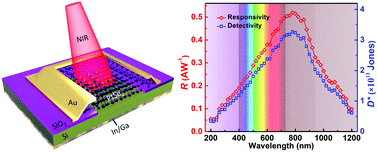High-performance broadband heterojunction photodetectors based on multilayered PtSe2 directly grown on a Si substrate†
Abstract
Two-dimensional group-10 transition metal dichalcogenides have recently attracted increasing research interest because of their unique electronic and optoelectronic properties. Herein, we present vertical hybrid heterojunctions of multilayered PtSe2 and Si, which take advantage of large-scale homogeneous PtSe2 films grown directly on Si substrates. These heterojunctions show obvious rectifying behavior and a pronounced photovoltaic effect, enabling them to function as self-driven photodetectors operating at zero bias. The photodetectors can operate in both photovoltage and photocurrent modes, with responsivity values as high as 5.26 × 106 V W−1 and 520 mA W−1 at 808 nm, respectively. The Ilight/Idark ratio, specific detectivity, and response speed are 1.5 × 105, 3.26 × 1013 Jones, and 55.3/170.5 μs, respectively. Furthermore, the heterojunctions are highly sensitive in a broad spectral region ranging from deep ultraviolet to near-infrared (NIR) (200–1550 nm). Because of the strong NIR light absorption of PtSe2, the heterojunctions exhibit photocurrent responsivities of 33.25 and 0.57 mA W−1 at telecommunication wavelengths of 1310 and 1550 nm, respectively. Considering the excellent performance of the PtSe2/Si heterojunctions, they are highly suitable for application in high-performance broadband photodetectors. The generality of the above results also signifies that the proposed in situ synthesis method has great potential for future large-scale optoelectronic device integration.



 Please wait while we load your content...
Please wait while we load your content...